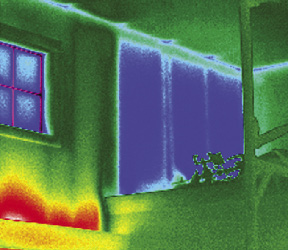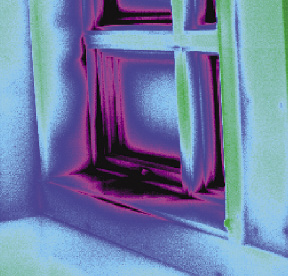Evaluating building envelope performance is becoming essential to management of today's facilities. Several factors are driving this trend, including rising energy costs, new construction techniques and materials, health concerns, and increased litigation and regulation. Specific issues like moisture damage, frozen pipes, ice dams, and occupant discomfort also prompt calls for building envelope analysis. Hit-or-miss attempts to solve these problems often waste time and money. The only technology able to deliver the 'big picture' of building envelope performance is heat-detecting infrared thermography. A professional infrared survey can quickly and affordably provide the information needed to guide cost-effective repairs.
Occupant Comfort
We were asked to troubleshoot occupant comfort issues in a large New York office building constructed with insulated metal panels. Infrared testing revealed a significant "stack effect"; warm air was escaping near the top of the building while cold air infiltrated the lower levels. The insulated panels performed well, but the gaskets between them allowed so much air infiltration that it was impossible to maintain a comfortable interior temperature.
At another project, the attic of a 150-year-old college building was converted into office space. After renovation, the entire floor experienced chilly interior temperatures, frozen pipes, and water damage. Infrared testing revealed poorly installed insulation in the walls and ceilings and an inadequate exterior air barrier. Our findings guided a successful effort to correct these problems.
Moisture and Mold
Prevention is always the best strategy when dealing with moisture and mold. While infrared testing does not directly identify mold, it can pinpoint the moisture that sets the stage for mold growth in walls and roofs. Early identification of water-damaged areas is the cheapest and most effective step in any plan for mold prevention and remediation.
Sometimes moisture infiltration begins in the roof system. Roof leaks and high interior humidity recently created a serious mold bloom in a northern Vermont elementary school, which cost $4.5 million to remediate and repair. The school district decided to take a proactive approach with their high school, ordering an infrared inspection to locate leaks and potential mold sites in the low-slope roof. We found 39 distinct areas of water-damaged roofing, which enabled the district to make repairs to prevent another expensive mold infestation.
Catastrophic Failures
Nondestructive testing can be invaluable when trying to assess damage and plan repairs following catastrophic failure. Several years ago, the attic sprinkler system of a wood-framed, fiberglass-insulated office building burst during an especially cold weekend, inundating the entire building.
Locating and mitigating moisture problems in the interior was relatively easy, but a big question remained; how much of the exterior wall system had been compromised?
Rather than completely stripping the drywall or randomly checking spots with a moisture meter, infrared thermography was employed to locate moisture damage in the exterior wall. Amazingly, despite the severe interior damage, only two small areas of moisture-damaged insulation were found in the exterior walls. This finding saved the owners tens of thousands of dollars in demolition and construction costs.
Post-Construction QC
Newly constructed or renovated buildings can have hidden design and construction flaws that create serious problems down the road. Our certified thermographers recently performed a quality control inspection of new construction on a college campus. Over fifty significant problem areas were identified, including improperly installed insulation, cold air infiltration through inadequate air and vapor barriers, and cold air leakage through poorly performing windows.
Dispute Resolution
When disputes arise in the course of a building project, it's a huge advantage to have an unbiased third party assess the situation. Infrared testing is often the best option because it provides an inherently objective 'big picture' of both the condition and performance of the facility. Identifying and isolating problems can help previously warring parties agree to work cooperatively on quick and cost-effective solutions.
Conclusion
Today's emphasis on increased insulation and air tightness can improve occupant comfort while substantially reducing energy consumption. However, it also makes the performance of the building envelope more critical to the health of the structure than in days past. Infrared building envelope analysis promises to play an increasingly important role in the design, construction, and maintenance of trouble-free and energy-efficient facilities.
Peter Brooks is director, sales and marketing for Infra-Red Analyzers, Inc., Williston, VT.











.png)